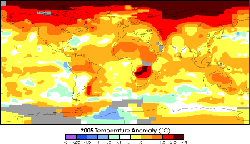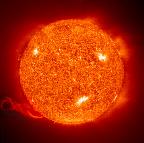What is it?
Global warming -- a gradual increase in planet-wide temperatures -- is now well documented and accepted by scientists as fact. A panel convened by the U.S National Research Council, the nation's premier science policy body, in June 2006 voiced a "high level of confidence" that Earth is the hottest it has been in at least 400 years, and possibly even the last 2,000 years. Studies indicate that the average global surface temperature has increased by approximately 0.5-1.0°F (0.3-0.6°C) over the last century. This is the largest increase in surface temperature in the last 1,000 years and scientists are predicting an even greater increase over this century. This warming is largely attributed to the increase of greenhouse gases (primarily carbon dioxide and methane) in the Earth's upper atmosphere caused by human burning of fossil fuels, industrial, farming, and deforestation activities.

Map showing the global surface temperature anomaly in 2005. Accoring to the NASA Goddard Institute for Space Studies (GISS), 2005 was one of the warmest years in over a century. Click image to enlarge.
Image credit: NASA Goddard Institute for Space Studies (GISS).
Factors
Greenhouse Gases
The increase in greenhouse gases caused by human activity is often cited as one of the major causes of global warming. These greenhouse gases reabsorb heat reflected from the Earth's surface, thus trapping the heat in our atmosphere. This natural process is essential for life on Earth because it plays an important role in regulating the Earth's temperature. However, over the last several hundred years, humans have been artificially increasing the concentration of these gases, mainly carbon dioxide and methane in the Earth's atmosphere. These gases build up and prevent additional thermal radiation from leaving the Earth, thereby trapping excess heat.

"Power plants, cattle, and cars are some of the major contributors of greenhouse gases such as carbon dioxide and methane."- Earth Observatory Global Warming Article
Image Credit: NASA's Earth Observatory
Solar Variability & Global Warming
Some uncertainty remains about the role of natural variations in causing climate change. Solar variability certainly plays a minor role, but it looks like only a quarter of the recent variations can be attributed to the Sun. At most. During the initial discovery period of global warming, the magnitude of the influence of increased activity on the Sun was not well determined.
 Solar irradiance changes have been measured reliably by satellites for only 30 years. These precise observations show changes of a few tenths of a percent that depend on the level of activity in the 11-year solar cycle. Changes over longer periods must be inferred from other sources. Estimates of earlier variations are important for calibrating the climate models. While a component of recent global warming may have been caused by the increased solar activity of the last solar cycle, that component was very small compared to the effects of additional greenhouse gases. According to a NASA Goddard Institute for Space Studies (GISS) press release, "...the solar increases do not have the ability to cause large global temperature increases...greenhouse gases are indeed playing the dominant role..." The Sun is once again less bright as we approach solar minimum, yet global warming continues.
Solar irradiance changes have been measured reliably by satellites for only 30 years. These precise observations show changes of a few tenths of a percent that depend on the level of activity in the 11-year solar cycle. Changes over longer periods must be inferred from other sources. Estimates of earlier variations are important for calibrating the climate models. While a component of recent global warming may have been caused by the increased solar activity of the last solar cycle, that component was very small compared to the effects of additional greenhouse gases. According to a NASA Goddard Institute for Space Studies (GISS) press release, "...the solar increases do not have the ability to cause large global temperature increases...greenhouse gases are indeed playing the dominant role..." The Sun is once again less bright as we approach solar minimum, yet global warming continues.
Trends & Effects
According to the Intergovernmental Panel on Climate Change (IPCC), average global temperatures may increase by 1.4-5.8ºC by the end of the 21st century. Although the numbers sound small, they can trigger significant changes in climate. (The difference between global temperatures during an Ice Age and an ice-free period is only about 5ºC.) Besides resulting in more hot days, many scientists believe an increase in temperatures may lead to changes in precipitation and weather patterns. Warmer ocean water may result in more intense and frequent tropical storms and hurricanes. Sea levels are also expected to increase by 0.09 - 0.88 m. in the next century, mainly from melting glaciers and expanding seawater . Global warming may also affect wildlife and species that cannot survive in warmer environments may become extinct. Finally, human health is also at stake, as global warming may result in the spreading of certain diseases such as malaria, the flooding of major cities, a greater risk of heat stroke for individuals, and poor air quality.
For more information on global warming in general and student activities and research topics in particular, visit:
- CNN.com- Study acquits sun of climate change (9/15/2006)
- An MSN news report that Earth warmest in at least 400 years, panel finds and a related CNN story Study: Earth 'likely' hottest in 2,000 years
- The Exploratorium's Global Climate Change website.
- U.S. Environmental Protection Agency Global Warming Site
- Conservation Science Institute Ocean initiative -- Check out their Global Climate Change page.
- The Role of the Sun in Climate Change by Douglas V. Hoyt and Kenneth Schatten; Oxford University Press, 1997. ISBN: 0195094131
- Web-based student activities. Designed to help students investigate global warming using web-based resources.
- The NASA Goddard Institute for Space Studies (GISS) Includes information about current research related to global warming.
- Global Warming- Overview of global warming (NASA Earth Observatory).
- Primate evolution linked to global warming says new study- New research suggests the ancient climate change fueled early primate evolution (mongabay.com).
Books from AMAZON.COM
Plows, Plagues, and Petroleum: How Humans Took Control of Climate
An excellent book, written by one of the world's top paleoclimatologists, but understandable to both scientist and nonscientists alike. Ruddiman summarizes, explains with research and facts, and places in context the influence of humans on atmospheric composition, climate and global warming. His focus is on the big picture -- changes to climate over the last 400,000 years with special attention to changes beginning 8,000 years ago. He makes only brief mention of solar variability as affecting climate (because his focus is on longer trends), but he does an excellent job of describing how small complications in the Earth's orbit cause regular glaciation on 100,000, 41,000, and 22,000 year timeframes. Note that a primary hypothesis of his book is the suggestion that early human agriculture started having an effect on the Earth's climate as early as 8,000 years ago. This is an intriguing idea which is still waiting for further scientific verification or discredit. However, the information in Ruddiman's book is still immensely useful in understanding current global warming and climate change.
No comments:
Post a Comment